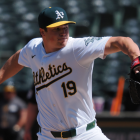
In an effort to improve the pace of play and create more action on the field, Major League Baseball this season will implement a series of rule changes designed to do exactly that. Matt Snyder already broke down everything you need to know about the pitch clock. Now we're going to look into the ban on extreme infield shifts.
Here is an overview of the new rules and here are the specifics regarding the new limitations on extreme shifts:
- The defense must have four players on the infield with two players on each side of second base. Infielders must have both feet on the infield dirt when the pitch is released. They can play in on the infield grass.
- Infielders cannot switch positions within an inning, so you can't continually swap your shortstop and second baseman to put the better defender on the side the batter is most likely to hit the ball.
- The rule prohibits four-man outfields, which started to become popular last season. An outfielder can still be brought in for a five-man infield, however, and that player can be positioned anywhere.
- The penalty for an improper defensive alignment is an automatic ball or the result of the play.
Similar rules were tested at various levels in the minor leagues and the results were mixed. At some levels there was no change to the league batting average on balls in play, and at some levels it rose by as much as three points. Truth be told, no one really knows what to expect with the new ban on extreme shifts. It could boost the league batting average a lot, or it could make little difference. We'll all find out together this season.
That said, there are certain hitters who figure to benefit from the shift more than others. Lefties who pull the ball have been hurt most by the shift, though righties get shifted too. These were the most shifted players in 2022 (min. 300 plate appearances):
| Right-handed batters | Left-handed batters |
|---|---|
1. Eugenio Suárez: 80.9% of plate appearances | 1. Carlos Santana: 98.1% of plate appearances |
2. Byron Buxton: 78.8% | 2. Cal Raleigh: 96.2% |
3. Luke Voit: 76.9% | 3. José Ramírez: 93.9% |
4. Salvador Perez: 75.6% | 4. Rougned Odor: 93.8% |
5. Marcus Semien: 75.4% | 5. Kole Calhoun: 93.4% |
MLB average for RHB: 19.6% | MLB average for LHB: 55.5% |
Last season, 105 players had at least 300 plate appearances left-handed and 11 of them saw the shift at least 90 percent of the time. Thirty-six saw the shift at least 75 percent of the time. The 24 most shifted players last year were left-handed. You didn't need me to tell you lefty batters will benefit from the ban on extreme shifts more than righties, but there you go.
To get an idea which hitters might benefit the most from the ban on extreme shifts, let's look at the hitters who made the most outs on balls into the shift last season. Here's the top 10:
- Corey Seager: 123 outs into the shift (92.8 percent shift rate)
- Josh Naylor: 95 (77.1 percent)
- Rowdy Tellez: 86 (78.4 percent)
- Freddie Freeman: 81 (52.1 percent)
- Matt Olson: 80 (81.3 percent)
- Charlie Blackmon: 79 (73.0 percent)
- Kyle Tucker: 79 (90.9 percent)
- Shohei Ohtani: 78 (88.3 percent)
- Max Kepler: 77 (89.7 percent
- Yordan Alvarez: 72 (88.1 percent)
Seager led baseball in outs into the shift by a good margin last season and that is in no way surprising. He pulls the ball a healthy amount, he has one of the highest shift rates in the league, and his low strikeout and walk rates equal a ton of balls in play.
It's easy to think a lefty slugger like Kyle Schwarber will benefit greatly from the shift, and I'm sure he will at times, but keep in mind that Schwarber is the anti-Seager when it comes to putting the ball in play because he walks and strikes out so much. Schwarber had 669 plate appearances last year and put 379 balls in play. Seager had 663 plate appearances and put 495 balls in play. A guy like Schwarber or Joey Gallo will have fewer opportunities to beat the shift because they don't put the ball in play as often.
One thing we can not do is simply take a player's batting average without the shift and say that's who he'll be with the new rules. That's like taking a Rockies player's stats outside Coors Field and saying that's the real him. We have plenty of examples telling us that's not how it works. It's an overly simplistic approach that omits so many important factors.
That doesn't work with the shift because, first and foremost, teams still have a good deal of flexibility when it comes to aligning their infielders. They can still put someone close to the second base bag to take away that ground ball single up the middle, for example. Also, the record-keeping is not precise. Here's a sample ground out from Seager, our man of the hour:
Seager rolled over on that pitch and hit it into the shift, right? Well, yes, technically he did given where the shortstop was positioned (on the second base side of the bag), but that's a routine ground out to second. That's an out with or without the shift, yet it goes into the books as an out into the shift. Last season, lefty batters had a .298 batting average on balls in play with no shift. With the shift, that number dropped to .274. That doesn't mean we'll see a surge of 22 points. There's a lot of nuance in play here.
No one really knows whether or how much the shift will have the intended effect and create more hits and more action. Further complicating things is the fact batting average fluctuates year to year. Jose Altuve is one of the best hitters for average in the sport, and in his last four 162-game seasons, he hit .316, .298, .278, .300. That's a spread of 38 points. Did Altuve's talent level change? Or is that just the way the ball rolled in those years?
Just to pick on someone other than Seager, Anthony Rizzo (82.6 percent shift rate) hit .224 in 2022 and .248 in 2021. If he comes out and hits, say, .240 this season, does that mean he got help from the ban on extreme shifts? Or is that normal year-to-year variance? It will be difficult to know what's attributable to the shift and what's normal baseball variance.
Given how often he puts the ball in play and how often he's seen extreme shifts over the years, it stands to reason Seager will benefit from the ban on extreme shifts as much as any player in the sport. As for how much it'll help the league overall, I don't think anyone knows the answer to that question, not even MLB itself. Check back in 162 games.






















